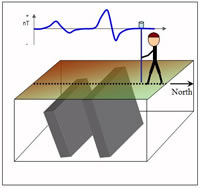| |
 Recall
that the anomaly pattern recorded over any given target depends upon
latitude, target orientation, profile orientation, remanent
magnetization of the target, and possible superposition of adjacent
targets. To illustrate, here we show the anomaly recorded over two
dykes buried at different depths. The dykes are assumed to extend to
very great distances into and out of the page (they are 2D targets),
and north is to the right (you are looking west), except in figure 3.
The sketch to the right illustrates the situtation. The figures below
show how data over these dykes will depend on latitude, line
orientation, target orientation, and so on. On the graph of the line
profile data, note the changes in vertical scale as well as the changes
in shape of the graph. Recall
that the anomaly pattern recorded over any given target depends upon
latitude, target orientation, profile orientation, remanent
magnetization of the target, and possible superposition of adjacent
targets. To illustrate, here we show the anomaly recorded over two
dykes buried at different depths. The dykes are assumed to extend to
very great distances into and out of the page (they are 2D targets),
and north is to the right (you are looking west), except in figure 3.
The sketch to the right illustrates the situtation. The figures below
show how data over these dykes will depend on latitude, line
orientation, target orientation, and so on. On the graph of the line
profile data, note the changes in vertical scale as well as the changes
in shape of the graph.
|
|

